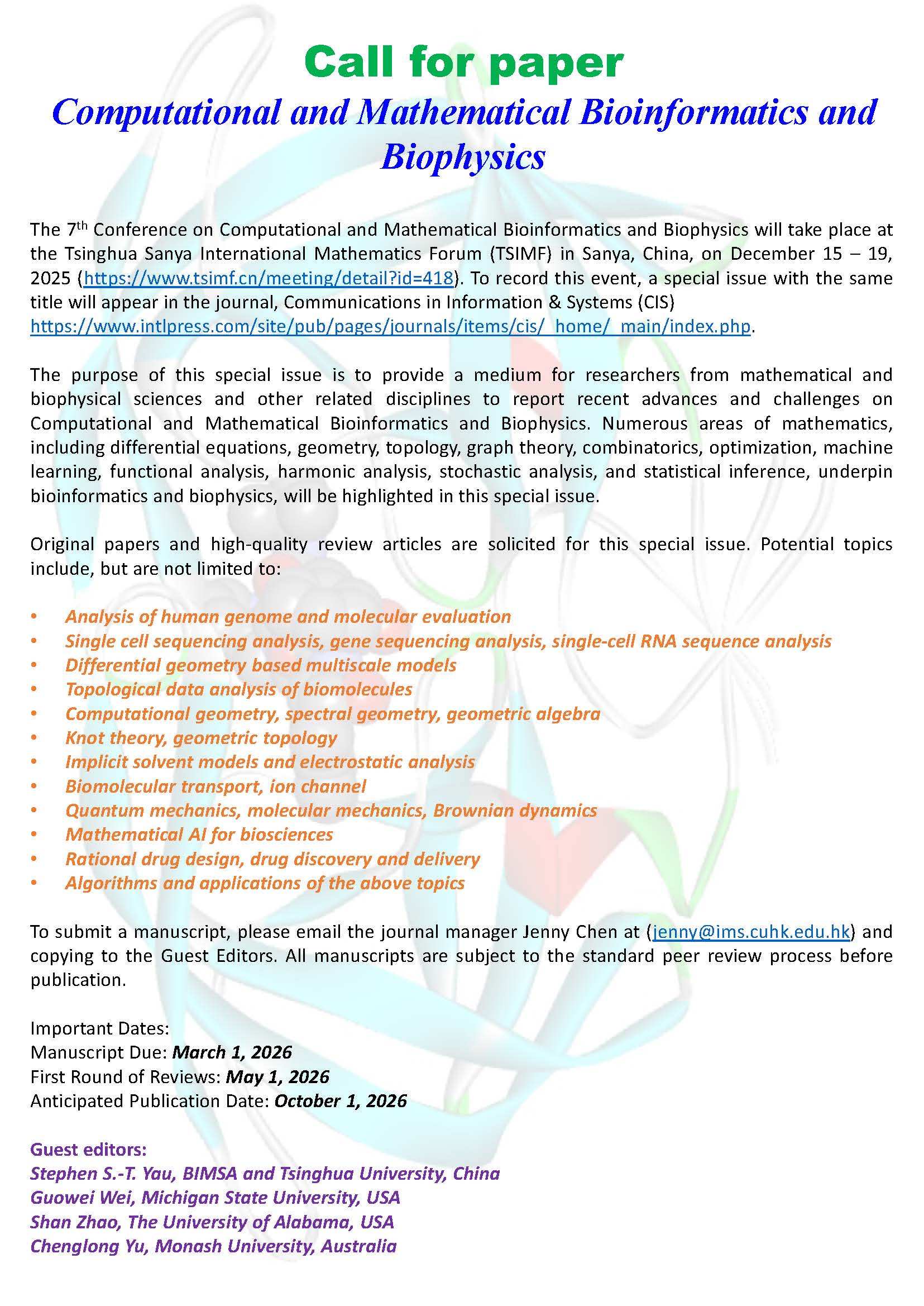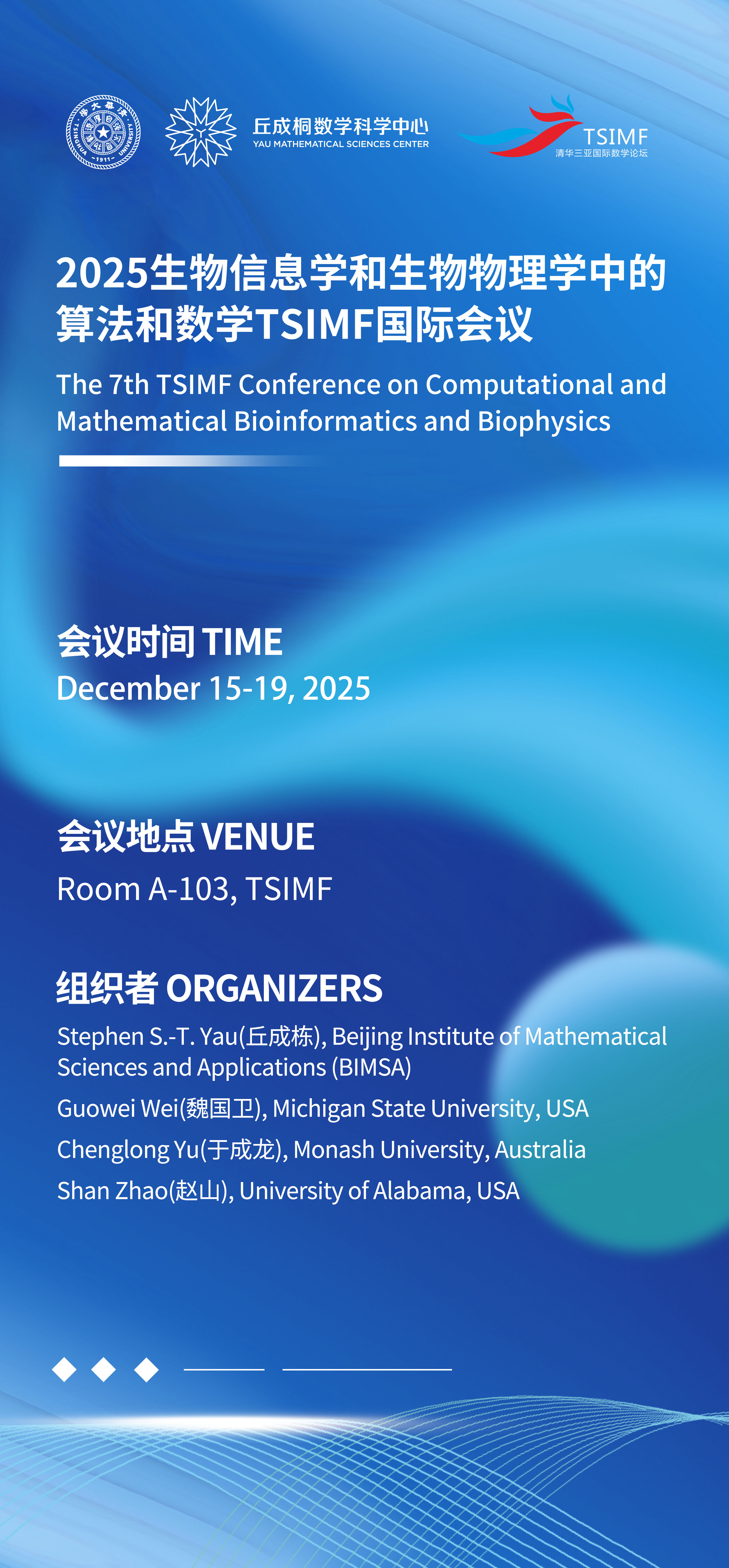Abstract
Description of Activity
We propose the 7th TSIMF Conference on Computational and Mathematical Biophysics and Bioinformatics to be held at Tsinghua Sanya International Mathematics Forum (TSIMF) in the December 2025.
Rationale
The proposed workshop on “Computational and Mathematical Biophysics and Bioinformatics” will bring together researchers from mathematics, biostatistics, chemistry, biochemistry, biophysics, and molecular/cell biology to explore new ways to bridge these diverse disciplines, and to facilitate the use of mathematics to solve open problems at the forefront of the biophysics and bioinformatics.
An important trend in contemporary life sciences is that with the availability of modern biotechnologies, traditional disciplines, such as physiology, plant biology, neuroscience etc., are undergoing a fundamental transition from macroscopic phenomenological ones into molecular based biosciences. In parallel with this development, a major feature of life sciences in the 21st century is their transformation from phenomenological and descriptive disciplines to quantitative and predictive ones. Revolutionary opportunities have emerged for mathematically driven advances in biological research. Experimental exploration of self-organizing molecular and cellular biological systems, such as SARS-CoV-2, molecular motors and proteins in Alzheimer's disease, are examples of dominating driving forces in scientific discovery and innovation in the past few decades. However, the emergence of excessive complexity in self-organizing biological systems poses fundamental challenges to their quantitative description, because of the excessively high dimensionality and the complexity of the processes involved. Mathematical approaches that are able to efficiently reduce the number of degrees of freedom, and model complex biological systems, are becoming increasingly popular in biosciences. Multiscale modeling, manifold extraction, sequencing analysis, topological simplification, dimensionality reduction and machine learning techniques are introduced to reduce the complexity of biological systems while maintaining an essential and adequate description of the molecules and cells of interest.
Scope
The workshop will cover a wide range of topics in mathematical modeling of biophysics and bioinformatics, and their applications to specific research problems. Example topics include comparative analysis of human genome and molecular evolution, mechanism of bacterial drug resistance, genome variation polymorphism, genome correlation of important diseases, single-cell sequencing analysis, high-throughput gene sequencing analysis, differential geometry based multiscale models, topological simplification of biomolecules, GLMY homology, natural vectors, Yau-Hausdorff distance, geometric algebra, knot theory of DNA, RNA and proteins, implicit solvation models, Poisson-Boltzmann equation, generalized Born models, polarizable continuum models, integral equation models, density functional methods, Poisson-Nernst-Planck equations, Micro-macro models, continuum-discrete models, microfluidics, biomolecular transport, multiscale Brownian dynamics, electrokinetics, electrohydrodynamics, quantum mechanics, molecular mechanics, and coarse-grained models. Emphasis will be placed on the application of the aforementioned models, theories and methods to precision medicine, early warning of virus and microorganism disasters, large data database construction and retrieval technology for genomic, proteomic, spatiotemporal single-cell transcriptomic data processing, pharmaceutical software technology, DNA packing, DNA-protein interaction, protein-protein interaction, protein-ligand interaction, mathematical AI for biosciences, topological deep learning for biosciences, single-cell RNA sequence analysis, spatial transcriptome data, multiomic analysis, ion channel dynamics, ionic transport in nanopore membranes, rational drug design, drug discovery and delivery, macromolecular self assembly and dynamics of molecular motors.
Description of the aim
Objectives
• To develop multiscale mathematical models that can effectively utilize current computational capabilities.
• To advance our understanding of the complexity of human genome and biomolecular structure, function, dynamics, and transport.
• To foster new ties, interaction and collaboration between mathematicians, bioinformatics scientist, biophysicists, and molecular biologists.
• To provide a forum to exchange ideas and results related to research in bioinformatics and biophysics.
• To help stimulate information flow of “biology to mathematics”, i.e., to introduce new bio-inspired mathematical models to graduate students and recent doctoral recipients in biology.
• To introduce the field and subject to graduate students, postdocs and junior faculty members, and help training the next generation researchers in the field.
• To enhance the participation of women, under-represented minorities, and persons with disabilities in the research of molecular based mathematical biology.
Impact
Currently, a major barrier for mathematical scientists to work in biophysics and bioinformatics is the lack of knowledge in molecular and cellular biology, while a major barrier for biologists is the lack of knowledge about modern mathematical tools and techniques that have been developed in the past few decades. This workshop series is designed to help bridge gaps between biologists and mathematical scientists and to facilitate their collaborations. There is enormous potential in this area for integrative interdisciplinary research in which theoreticians and experimentalists develop solutions to challenging problems in tandem. This workshop series will act as a catalyst to fully exploit these synergies, and create a network of collaborations that will sustain future activities in this area beyond the duration of this workshop.
Previous Achievements
The TSIMF annual workshop series on “Computational and Mathematical Biophysics and Bioinformatics” has been successfully held for six times from 2018 – 2024. Four workshops were in-person events and took place at the Sanya, while the third and fourth workshop was held online through the Zoom in Dec. 2020 and Dec. 2021, respectively.
To record these CMBB workshops, five special issues have been published from 2018 – 2024 in the journal: Communications in Information & Systems (CIS)
https://www.intlpress.com/site/pub/pages/journals/items/cis/_home/_main/index.php.
The numbers of papers published in these five special issues are 6, 10, 7, 5, and 7 respectively. The special issue for the sixth workshop will be published in the CIS in 2025.
These previous CMBB workshops and the associated special issues have attracted more people from mathematics and biology to work on the modeling and computation of biophysics and bioinformatics, and fostered further collaborations among them. Based on our previous successful achievements, we are confident that the proposed TSIMF workshop series will stimulate new research directions in mathematics and computation to address fundamental challenges in biophysics and bioinformatics.
Number of Participants
In the preliminary list of proposed participants below, we have listed more than 50 people. Please note that not every invitee will accept the invitation. Moreover, the first come and first serve principle will be applied so that we can guarantee that the number of participants will not exceed 50.


丘成栋, 北京雁栖湖应用数学研究院
魏国卫,密歇根州立大学
于成龙,莫纳什大学
赵山,阿拉巴马大学